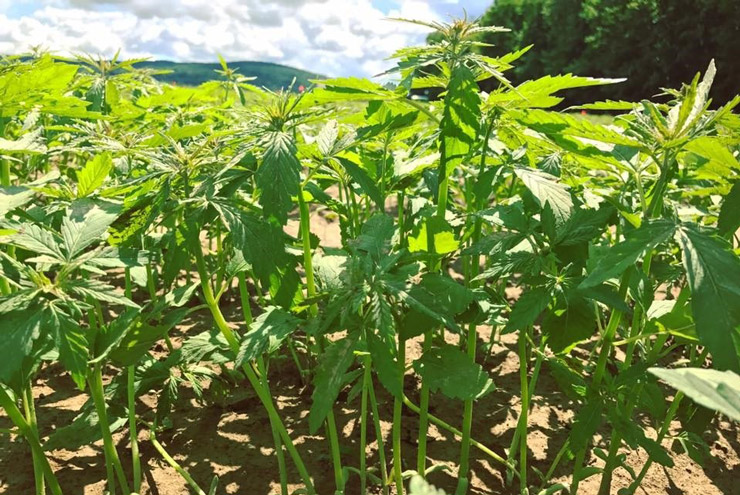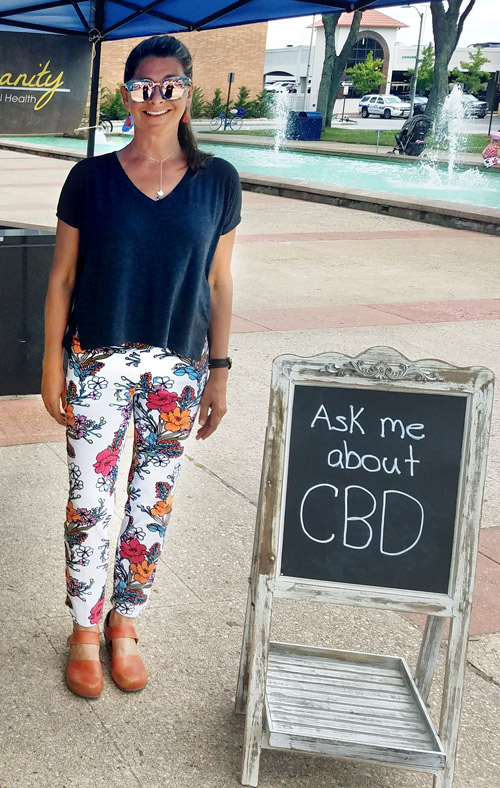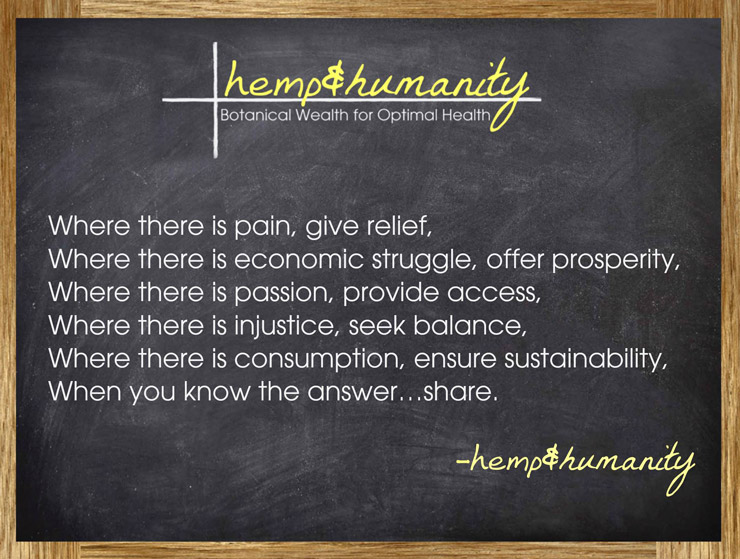Struggling with chronic illness and determined to restore her once vibrant health, Melissa Gibson discovers the healing power of CBD — and a path of purpose
—
“Wow! You’re back to being Melissa!”
We hadn’t seen each other in almost a year, and the joy in my friend’s voice brought tears to my eyes. It had been a rough few years as far as my health was concerned, and she couldn’t have been happier to observe the difference since our last visit. I had test result numbers to prove that my life-changing thyroid condition was improving, but this statement by someone who has known me my entire adult life was true confirmation of my ‘return to me’.
My Body & Me
Health, fitness, and wellness were central to my life from the time I was a little girl (all the while trying to keep up with my big brother), through my late forties, when I did my best to manage the aging process by staying active and eating well. At age 48, I was still able to hold my own on the beach volleyball court and compete in snowboarding races where I consistently won in my age group.
All of that changed in late December 2013, on a family snowboarding trip to Lake Placid. After a full day of riding in the gorgeous Adirondack Mountains, I woke my husband from a deep sleep, screaming that someone was knocking loudly on the door to our hotel room. It was 3 o’clock in the morning, and I was sweating with fear. As it turns out, I was the only one that could hear the noise. There was no knocking. The loud, rhythmic banging was the sound of my own heart beating in fast, powerful pumps that reverberated in my ears. This, along with an almost twenty-pound weight loss over the next two weeks, severe fatigue, stomach cramps, anxiety, tremors in my hands, and an overall sense of extreme agitation, were the symptoms of something called a Thyroid Storm.

I learned that this condition is a severe and potentially life-threatening complication of hyperthyroidism, or overactivity of the thyroid gland. In my case, this was caused by Graves’ disease, which is an immune system disorder that results in the overproduction of thyroid hormones.
Aha! My immune system. My Achilles heel.
In 2003, I had contracted Lyme Disease; in 2005, I was diagnosed with Celiac Disease. One causes an autoimmune response, and the other is an autoimmune disorder. While Celiac Disease can be managed by eating a gluten-free diet, Lyme Disease is more insidious. Even after short-term treatment with large doses of antibiotics, Chronic Lyme Disease symptoms can linger, including joint and muscle pain, as well as fatigue and ‘brain fog’. For me, this manifested in severe pain throughout the joints in my wrists, hands and fingers, which I treated with physical therapy, massage therapy and ultimately, with pain medication that wasn’t friendly to my digestive system.
So, at age 49, despite my commitment to healthy living, I was a veritable potpourri of autoimmune diseases: Celiac, Lyme and Graves’, Oh My!!
And to add an additional level of fun, the Thyroid Storm I suffered kicked me into menopause. When your body feels overheated from a hyperactive thyroid, adding hot flashes to the mix is a true joy… said no one.
Treatment began with taking medications to inhibit my thyroid from overproducing hormones and to protect my heart. I added yoga and meditation to my life and enjoyed the benefits of keeping my inner workings in balance. Every few months, I would see the endocrinologist for an exam and to test my thyroid levels. Fortunately, the impact of the disease can be measured. My thyroid counts provided a report card on how my body was reacting to treatment. For the most part, there would be improvement from one appointment to the next. However, just when it seemed the condition was under control, my hormone levels would spike, progress was lost, and we would start the process over again.
My endocrinologist explained that the onset of my Graves’ Disease was likely caused by excessive stress. It made sense that the sharp uptick in my hormone levels was also caused by stress. This panned out when comparing the timing of certain events in my life to the reversal of my progress.
After almost two years of trying to bring about sustained remission, my doctor said it was time to consider more permanent solutions – either radiation, using radioactive iodine, or surgery (thyroidectomy) to remove my thyroid. These options are very common and are successful for the clear majority of patients.
There are still risks to these procedures, and both result in a lifetime of taking medication to replace the hormones, which can create other potential health issues. At the time, I was closed-minded about going down this road, and just tried to further reduce stress, focus on nutrition, stay active, and generally attempt to balance my life.
Note: Stress is the root of all evil. It’s considered to be the leading cause of health problems among women as we attempt juggle it ALL. As much as I tried to deal with stress factors under my control, there were some doozies outside of my control, including a very dark time with my oldest son.
My Hero
Just when I was on the verge of throwing in the thyroid towel, I was introduced to a hero that would impact every aspect of my life. It came in the form of a green, leafy, often misunderstood botanical that provides a wealth of properties to improve health and wellness. That hero is hemp.
Surprisingly, the key to my personal health came from my professional world. As a business development professional who works with entrepreneurs, grassroots organizations, and independent businesses to become strategically more socially conscious and sustainable, I first learned of hemp’s power while serving as an advisor to a nonprofit in upstate New York. Our interest in hemp as a sustainable, profitable crop was in its potential to improve the local economy of the Hudson Valley.

While my background includes a degree in Agriculture Economics from Cornell University, my career turned out to be all economics and no agriculture. The frame of reference I had for hemp was its somewhat confusing relationship to marijuana. It wasn’t until this project that I was exposed to its many applications (see image of 50,000 uses!), it’s rich history in the U.S., and its prominence around the world, including its use in many ancient civilizations. The more I learned, the more the message became clear: humans were meant to live symbiotically and synergistically with hemp.
It is through this exposure to hemp, that I became aware of a chemical compound called CBD (short for cannabidiol). Through its incorporation in my life, I have taken back my health.
CBD can be derived from either a hemp or a marijuana plant; however, its legality is defined based on from where it’s extracted. To clear things up a bit, hemp and marijuana are different varieties of the same species: cannabis. In simple terms, marijuana is grown for its flowers (buds), and hemp is grown for its stalks and seeds. The other significant difference between the two has to do with U.S. legislative language that identifies cannabis with less than .3% THC as ‘industrial hemp’, and cannabis with more than .3% THC as ‘marijuana’.
THC (Tetrahydrocannabinol) and CBD are two of over 140 chemical compounds found in cannabis. CBD is considered legal in each of the 50 states; however, it is also considered federally illegal, in that it’s derived from cannabis, which is a Schedule 1 Drug, according to the Controlled Substances Act. It’s confusing for sure.
CBD is legal to use and millions of people around the world rely on it to maintain their health. (Please refer to www.hempsupporter.com for more details regarding the current legal status of hemp, and to get involved with advocacy, if you feel called to do so. Joy Beckerman is also a valuable source of information, and a leading hemp advocate www.hempace.com)
Your Body & CBD
What does CBD have to do with wellness? First, know that CBD is non-intoxicating. You cannot ‘get high’ on CBD. It is an anti-inflammatory agent, a neuro-protectant, an anti-anxiety agent, and an antipsychotic. It has no contraindications, no side effects, and rather than potentially harming your gut lining like ibuprofen, it can actually improve the function of your digestive system.
In a nutshell, CBD works with our bodies to create homeostasis. As defined by Scientific American, “Homeostasis, from the Greek words for ‘same’ and ‘steady’, refers to any process that living things use to actively maintain fairly stable conditions necessary for survival.” Remember this term from biology class?
CBD is an agent of homeostasis, and physical homeostasis is the very definition of good health.
How CBD works to create homeostasis has everything to do with what is called the Endocannabinoid System, or the Master Modulator of all the other systems in your body. In her essential book, Vitamin Weed, neuroscientist Dr. Ross explains, “The endocannabinoid system modulates almost every physiological process of your mind and body including memory, pain, appetite, mood and reproduction. All these processes are highly influenced by your environment. But the cannabinoid system is there to fine tune cells, put on the brakes or ramp up cell activity and make sure no processes become pathologic. The endocannabinoid system (ECS) is the largest neurotransmitter system in your body. Cannabinoid receptors are present on almost every cell, regulating your brain, immune system, skin and every other organ in your body. The ECS helps your body deal with physical and emotional stress. Your energy, resilience to life’s obstacles, happiness and health are all dependent on a functioning Endocannabinoid system.”
Wow! It is astounding that science has only recently come to identify and understand the ECS. Its discovery is credited to Israeli scientist Raphael Mechoulam, who in 1964 was first able to isolate THC and CBD from the cannabis plant. This groundbreaking finding becoming the basis to discover that every mammal, bird, reptile and fish have some form of an Endocannabinoid system.

Incredibly, our body creates homeostasis by generating its own endocannabinoids (endo meaning ‘within’) that interact with the ECS. CBD and other plant-based cannabinoids called phytocannabinoids (‘from plants’), can be used to supplement our ECS and even fight diseases caused by ECS deficiency. These types of cannabinoids act in the same way as our own endocannabinoids, some by binding to the same cannabinoid receptors, and others by boosting levels of endocannabinoids. CBD is considered by many to be one of the most effective cannabinoids available in terms of restoring and maintaining health.
The main reason why CBD is often referred to as a ‘miracle’ compound is because CBD addresses systems, rather than just symptoms. It cascades through the body, creating balance and producing a therapeutic effect.
Typical pharmacologic solutions work on one symptom at a time, often creating other symptoms themselves. (Those commercials that spew endless potential adverse side effects comes to mind.) CBD helps our body to find balance. This essential nutrient can be a vital weapon against environmental toxins, stress overload, system deficiencies, mood disorders, and even addiction. We are only scratching the surface of its full potential.
I think CBD has the power to change the world.
That’s both a lofty statement — and the basis for dedicating the rest of my personal and professional life to educating others about its benefits. Imagine if the astronomical size of the collective minutes that adult women spend worrying about sleep, lacking in sleep and thinking about sleep, were reduced by even a fraction. What impact would that have on their lives and the lives of their families? Lack of sleep is one of the leading causes of chronic health conditions. Stress, anxiety, pain and inflammation all contribute to the inability to get a full night’s sleep. All these factors can be addressed by a healthy endocannabinoid system, and CBD can lead the charge.
Back to Me
A quick review of my health conditions prior to discovering CBD:
- Overactive thyroid (Graves’ Disease)
- Joint pain (Lyme and Celiac Disease)
- Brain fog (Lyme and Menopause)
- Hot flashes (Menopause)
- Anxiety (see 1-4)
Hopeful, optimistic, and armed with my new-found knowledge of the potential benefits of CBD, I began a daily regimen of consuming CBD, beginning in the spring of 2016. I started taking between 15mg and 45mg of CBD each day in a combination of liposomal spray in morning, topical balm as needed throughout the day, and either one or two capsules of oil at night. The results? My hot flashes and other menopausal symptoms subsided, I was better at controlling spiraling, anxious thoughts, my joint pain went away as soon as I applied my balm, and my ability to focus greatly improved.
Of course, this progress is self-reported and based on my own assessment of my health. Perhaps I was simply willing myself to feel better? A placebo effect?
I got my answers at a checkup with my endocrinologist six months later. Fully aware that I had been taking CBD (always discuss taking CBD with your doctor), he gave me the good news that my thyroid hormone counts had gone down significantly and recommended cutting my medication to a tiny fraction of the original amount. With joy and goodwill (we had been working together for years at this point), he told me the Graves’ Disease was headed into remission. As noted by my friend of many years, I was on my way back to me.
Your Turn
Once I experienced the incredible benefits of CBD for myself, I started telling everyone I knew about what I had discovered. Around the same time, CBD began trending. Claims, information, misinformation and disinformation about CBD were (and still are) rampant on the internet and in social media. There were so many questions: How do I know if I’m going to get my money’s worth? What should I look for when researching the best product for my needs? How is the CBD extracted from the plant? What delivery method should I use to take CBD? How much should I take?
The marketplace for CBD is unregulated, and as with any other nutraceutical, the landscape is fertile for snake oil salesmen. It’s certainly a Buyer Beware situation: a product can claim that it has ‘hemp extract’ or ‘hemp oil’ without specifying exactly how much CBD is present. A product can also claim it has any amount of CBD in it without having to provide proof. Consider the fact that although hemp seeds are an incredible source of essential fatty acids, hempseed oil contains zero CBD.
Just because a product contains hemp oil, it doesn’t necessarily contain CBD. Do not buy any CBD products unless the manufacturers provide third-party testing to make sure the CBD amounts are accurate and the amount of toxins and metals that could potentially be present are correctly measured. Also, make sure the product specifically states how much CBD is in each serving. Consistency is key.
Adding to the confusion is how the CBD is extracted. Some of the CBD available is extracted using butane. Yes, the same butane that is in lighters. It’s a cheap way to extract CBD, but some of it remains after the process. The best method is also the costliest and the cleanest.
Supercritical CO2 Extraction — Look for products and companies that use this method of extraction. Don’t go with the cheapest product out there. You’ll get what you pay for.
The method of CBD delivery and the amount needed can be confusing as well. CBD comes in a variety of forms, including tinctures, edibles, topicals, transdermals, liposomes, capsules, vape oils and cartridges, isolates, slow-release patches and aromatherapies. Some deliver effects immediately, some take longer, some last a few hours, others a full day. The amount of CBD varies from individual to individual and can even vary with the same individual from day to day. We each have different Endocannabinoid systems, health conditions, sensitivities, tolerances, etc. The most important thing to understand is that to be successful with CBD, you have to become engaged in the process of finding the ideal method and quantity for you.
The good news is that YOU have the power to determine what’s best for you. You can titrate up or down to find the most relief from the least amount of product. You can experiment with different delivery methods. Keep track and share the information with your health care providers to achieve your desired therapeutic effect.
You & Me
With my own CBD enlightenment, and with 25 years of helping others to develop their businesses and brands, in 2016 I created my own company: hemp&humanity. We are a quadruple bottom-line enterprise, so along with making a Profit, we focus on People, Planet and Purpose. We curate the best hemp-based products available. We also provide education about the power of hemp and CBD to improve the human condition. Our tag line is “Botanical Wealth for Optimal Health.” You can learn more at www.hempandhumanity.com

I have now personally coached hundreds of clients who have had their health conditions and lives improved through regular use of CBD. There’s the teenager who finds relief from menstrual cramps, the athlete looking to recover quicker from workouts, the 62-year-old woman managing her arthritis, the 47-year-old woman who replaced her nighttime sedative with CBD to wake up rested after a full night’s sleep, the young man who uses CBD to cope with social anxiety, the Dad who needs back pain relief to keep up with his kids, and my son — the 22-year old who uses CBD to recover from addiction to opiates.
The best part about my journey back to being me is that along the way, I have unlocked the potential of something to ease suffering for others. The old saying that if you don’t have your health, you don’t have anything is obvious to anyone who has ever had their health, or the health of a loved one, in jeopardy. CBD is not a panacea, but it has the potential to improve so many conditions that people struggle with daily. At a time when things seem to be spinning wildly, taking back the control and power to improve your own life is priceless. Power to the Plant! Power to the People! Power to the Planet!
—
Medical Disclosure: I am not a medical professional, and nothing in this piece is meant to be regarded as medical advice. However, having immersed myself in the emerging CBD industry for several years, I am confident that I have identified some of the most credible and trustworthy sources of information, such as Green Flower Media, Dr. Philip Blair, Dr. Dustin Sulak, and Dr. Michele Ross, a neuroscientist and author of Vitamin Weed. (See Sources for a more comprehensive list).
—
Hemp & CBD Resources
Dr. Michelle Ross, Vitamin Weed: A 4-Step Plan to prevent and reverse endocannabinoid deficiency. Greenstone Books, LA. 2018
Joy Beckerman www.hempace.com
Dr. Dustin Sulak, www.healer.com
Dr. Philip Blair, https://www.linkedin.com/in/philip-w-blair-m-d-37012822/
Shira Adler, The ABCs of CBD, ValPoSa Books, S. Salem, NY 2018
The National Center for Biotechnology Information www.pubmed.gov
The Realm of Caring www.troc.net
Women Grow www.womengrow.com
Marijuana Policy Project www.mpp.org
Word on the Tree www.wordonthetree.com
Leafly www.leafly.com
Dr. Junella Chin, www.medleafrx.com

You may also enjoy Interview: Kelly Brogan, MD | A Mind Of Your Own with Kristen Noel
